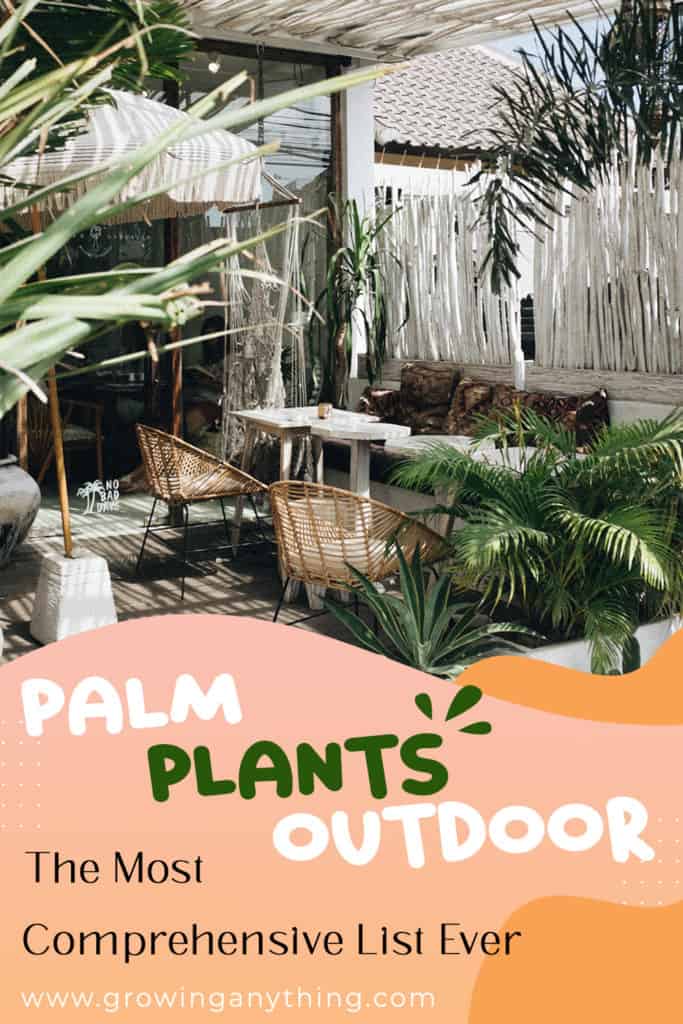81 Best Palm Plants Outdoor
Are you looking for palm plants outdoor-suitable? I have the most comprehensive list, where you will certainly find an outdoor palm for your patio, backyard, or balcony!
Who doesn’t love palms? They instantly add a tropical vibe to every outdoor space and bigger variants are great for making shade. Overall, palms aren’t difficult to grow. But, it applies only to palms you grow in the appropriate USDA hardiness zones.
The majority of palms do excellent in zones above nine, but you can find several that can stand colder weather too.
Most palms are tropical plants, so they need a lot of sunlight, warmth, and moisture to thrive.
Here is the comprehensive list, so don’t forget to screenshot your favorites!
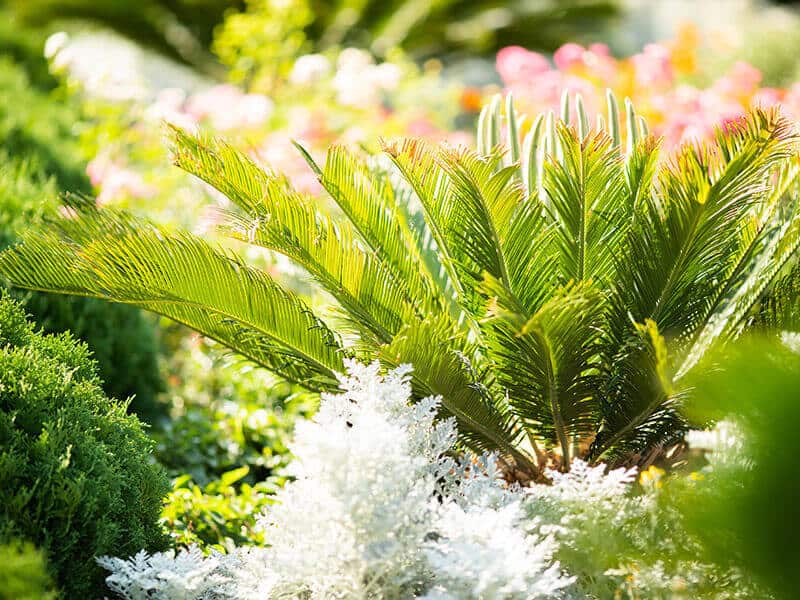
1. Chinese Fan Palm
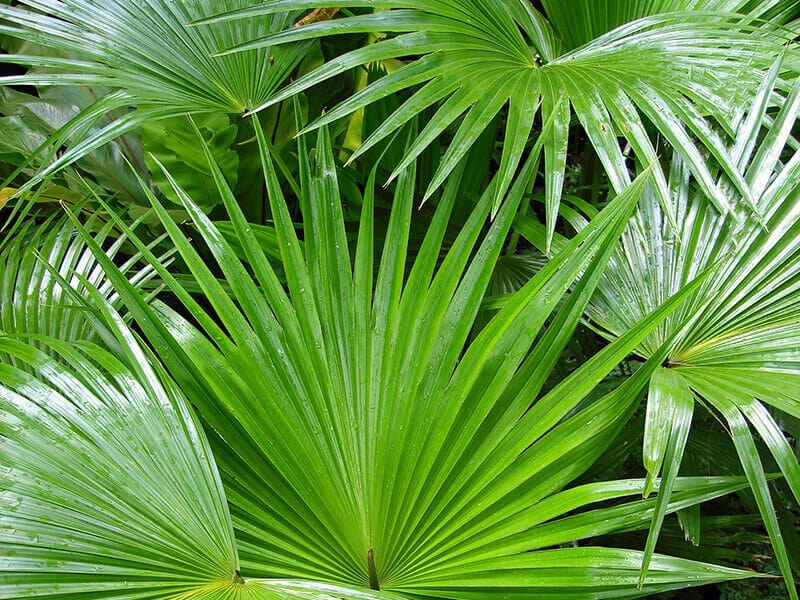
Livistona Chinensis or Chinese Fan Palm is a beautiful palm tree, used for landscaping. Because of the spectacular frond arch, the palm is sometimes called Fountain palm.
Plant it in the spring, in full sun location, and moist and well-drained soil. It thrives in loamy, acidic to neutral soil and develops interesting creamy flowers.
2. Cascade Palm
The botanical name of Cascade palm is Chamaedorea cataractarum. This small palm tree comes from Mexico and can be grown indoors and outdoors.
The palm needs partial shade outdoors, and weekly watering. During hot summer days, water Cascade palm twice a week for optimal development.
3. Broadleaf Lady Palm
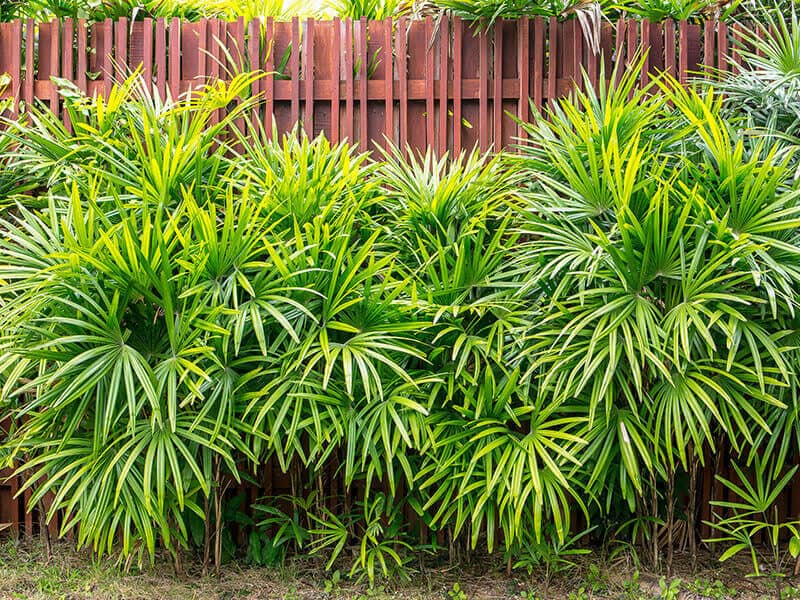
Rhapis excelsa grows between six and 15 feet. It is better known under the common name – Broadleaf Lady Palm.
The palm is drought-tolerant and often planted as a hedge. It also develops showy flowers and can survive indoors with proper care.
4. Kentia Palm
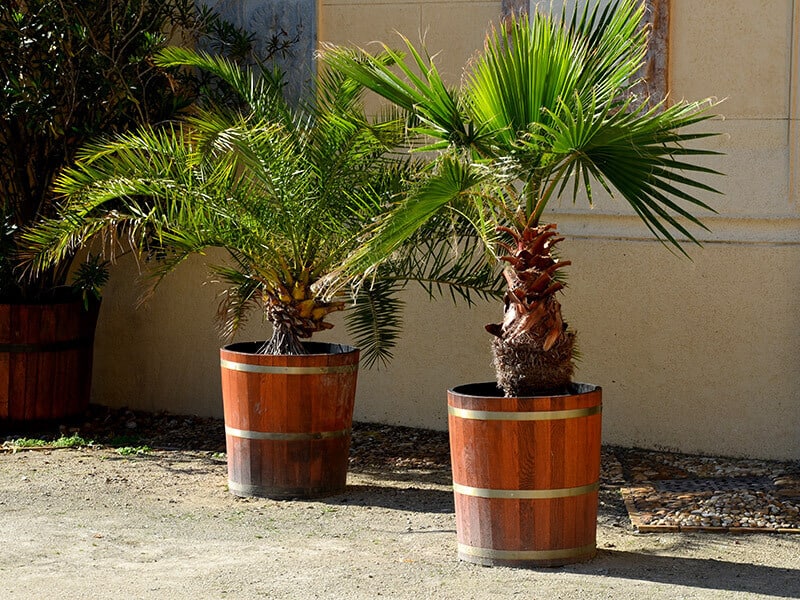
Howea forsteriana or Kentia Palm is a beautiful plant for tropical areas. It survives in California and Hawaii. The palm is a slow grower.
Kentia palm needs light shade, well-drained soil and a lot of water. However, when the temperatures drop, your Kentia will need less water.
You can see this video to know more:
5. Parlor Palm
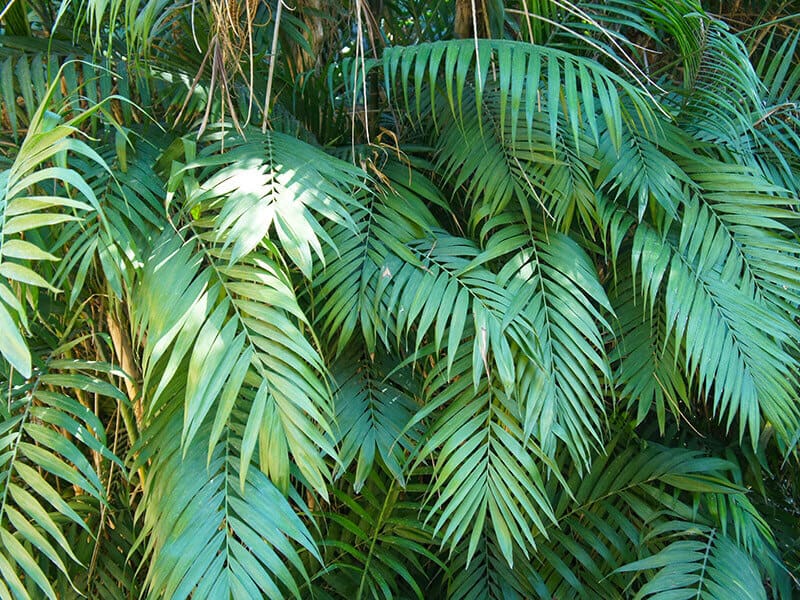
Chamaedorea elegans or Parlor palm needs protection from bright sunlight. Otherwise, the leaves can appear scorched. It needs a sheltered location, and a lot of water, especially during dry and hot summer. The plant needs protection when the temperatures drop below 55 degrees Fahrenheit.
6. Areca Palm
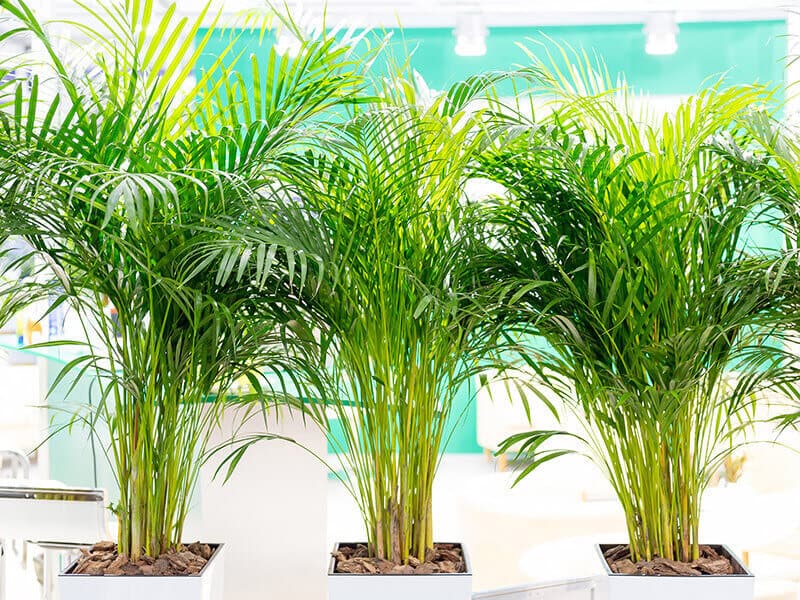
There are only a few palms with such an amazing visual impact like Areca palm. The botanical name is Dypsis lutescens.
Areca palm thrives in partial shade. You can add sand to the soil to improve drainage. Plant several Areca palms at three feet distance for the stunning effect!
7. Stone Gate Palm
Trachycarpus princeps or Stone Gate palm is a rare and beautiful palm, native to China. The plant needs full sun exposure and warm temperatures to survive. In its native habitat, Stone Gate palm grows up to 30 feet! In your backyard, the palm will certainly grow shorter.
8. Sylvester Palm
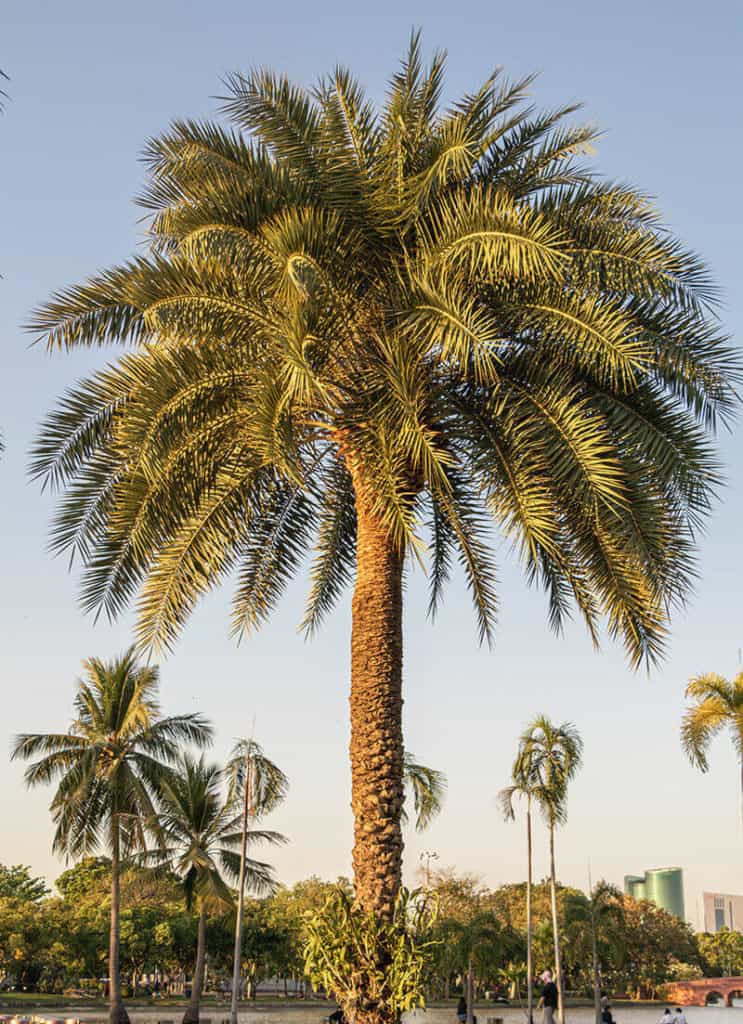
Phoenix sylvestris or Sylvester palm is best-known for its blue-green foliage. You can grow it from seeds easily. It needs a lot of sunlight and moderate water.
Sylvester palm needs light pruning. You need to remove old leaves because those will ruin the appearance of the palm.
The correct way to prune every palm.
9. Ribbon Fan Palm
Livistona decipiens is the scientific name of the popular Florida Ribbon Fan palm. It features lovely fan-shaped foliage with split ends that look like ribbons.
The plant is hardy and easy to grow. You need to water the plant regularly and remove old leaves to keep it good-looking!
10. Paurotis Palm
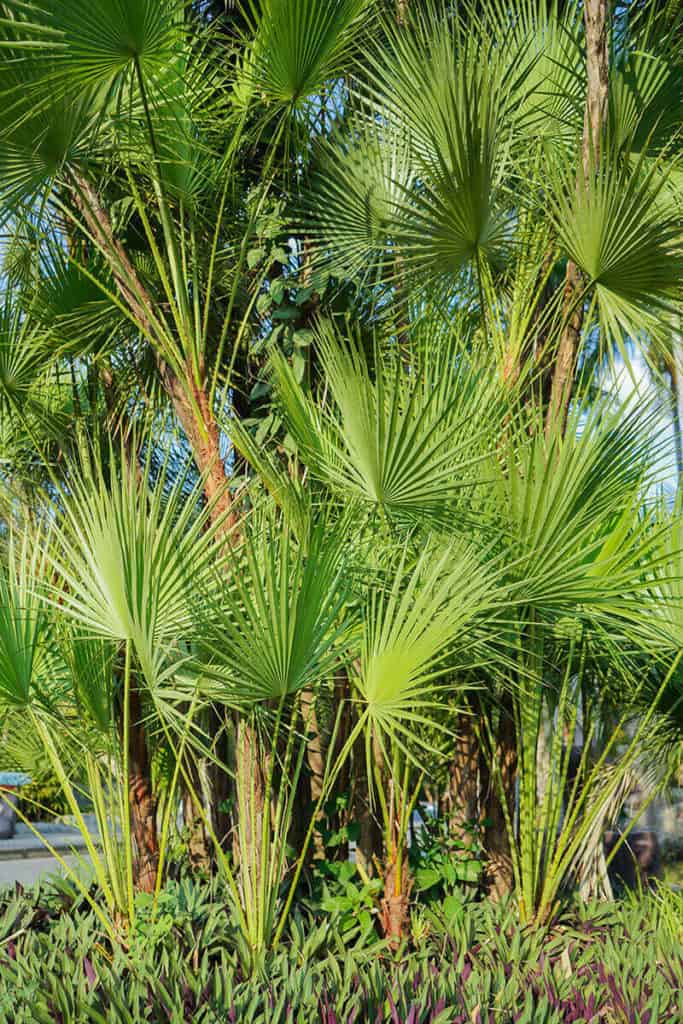
Acoelorrhaphe wrightii or Paurotis palm is a beautiful single-trunk, tropical plant. You can grow the palm in full sun or partial shade location, ideally in zone 9B.
Paurotis palm can grow up to 25 feet and needs only simple maintenance.
11. Alexander Palm
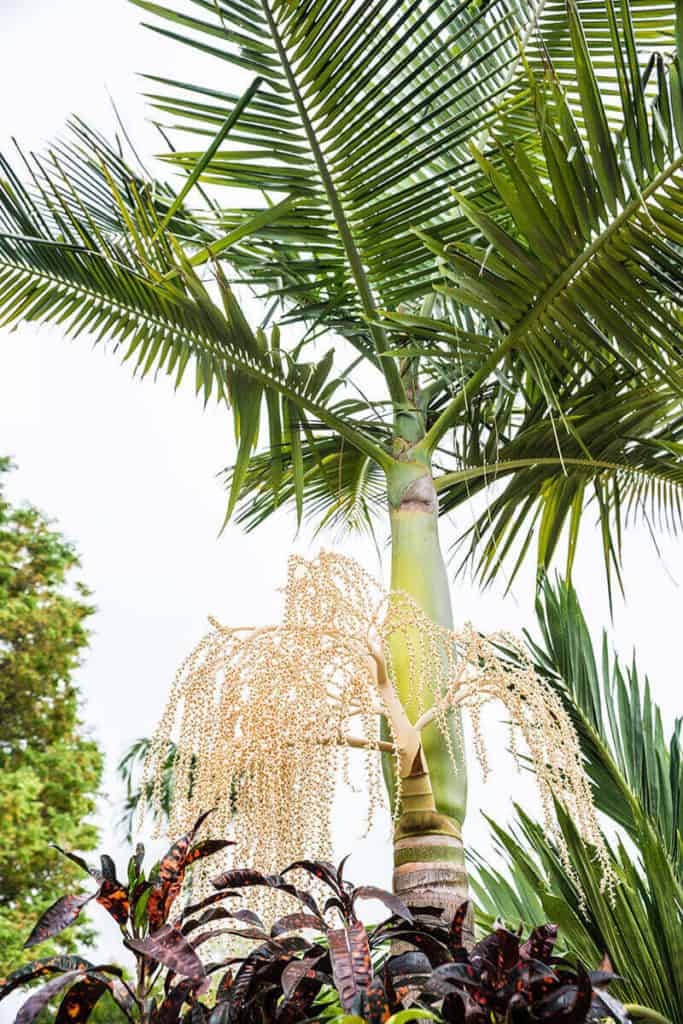
Archontophoenix alexandrae or Alexander Palm is a magnificent palm, excellent for landscaping. When you plant it, Alexander palm will thrive in light shade. However, mature palms prefer full sun exposure.
Alexander palm is grown for beautiful foliage and wonderful creamy flowers. In autumn, the palm develops tiny red fruits!#12
12. African Oil Palm
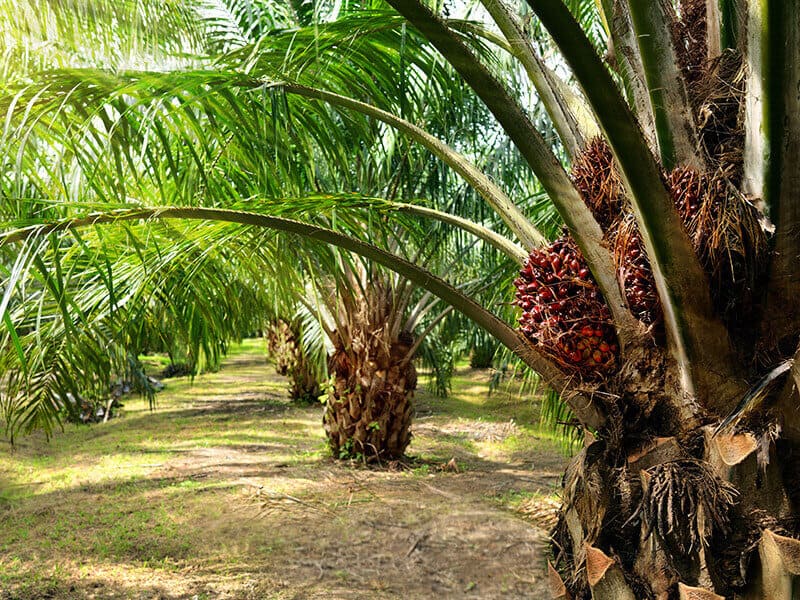
Elaeis guineensis or African Oil palm is a tropical tree. It prefers warm temperatures and high humidity. Plant it in the bright spot, in fertile soil, and ensure consistent watering.
It gets around 30 feet tall and develops a lovely crown.
13. Red Sealing Wax Palm
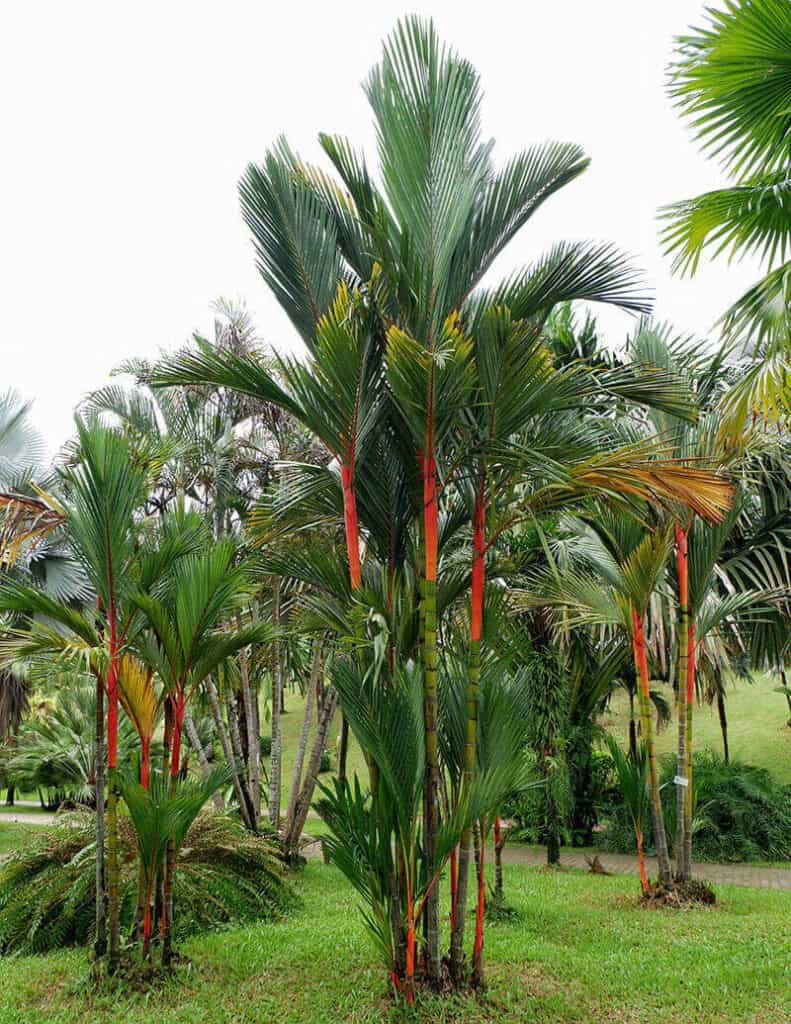
Cyrtostachys renda is known under many names – Lipstick palm and Red Sealing Wax palm are some of them.
It features red leaf sheets that stand out against green foliage. The plant has high ornamental value and isn’t difficult to grow.
Check out this video to know:
14. Bismark Palm
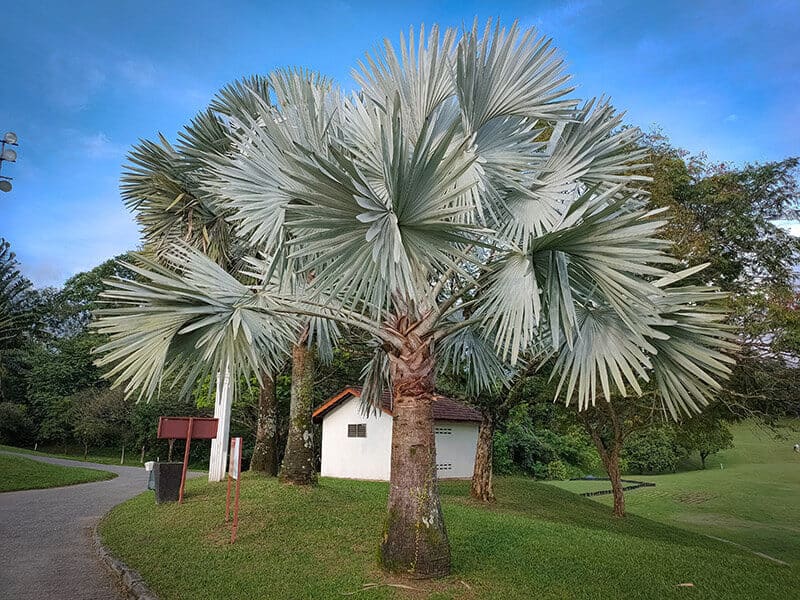
Bismark palm is another grand fan palm. It is native to Madagascar and features a stout trunk and elegant symmetrical crown. Bismarckia nobilis needs a lot of sunlight, wind protection and a lot of water, especially at an early age.
Established Bismark palms are drought-tolerant.
15. Cuban Royal Palm
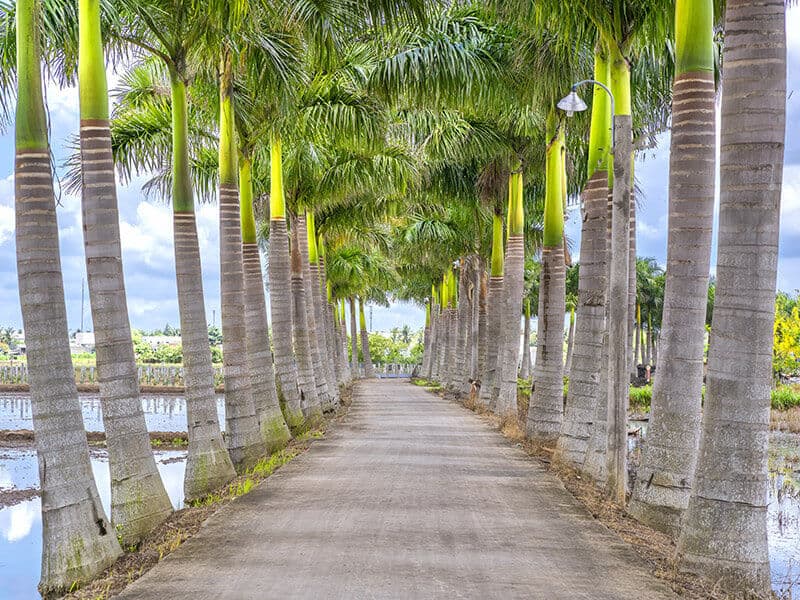
Roystonea regia or Cuban Royal palm is native to Central America. The palm is fast-growing and elegant, and you can often see it as an ornamental tree around the road.
Cuban Royal palm enjoys high humidity and a lot of moisture. It is also somewhat cold-tolerant and can survive light frosts.
16. Queen Palm
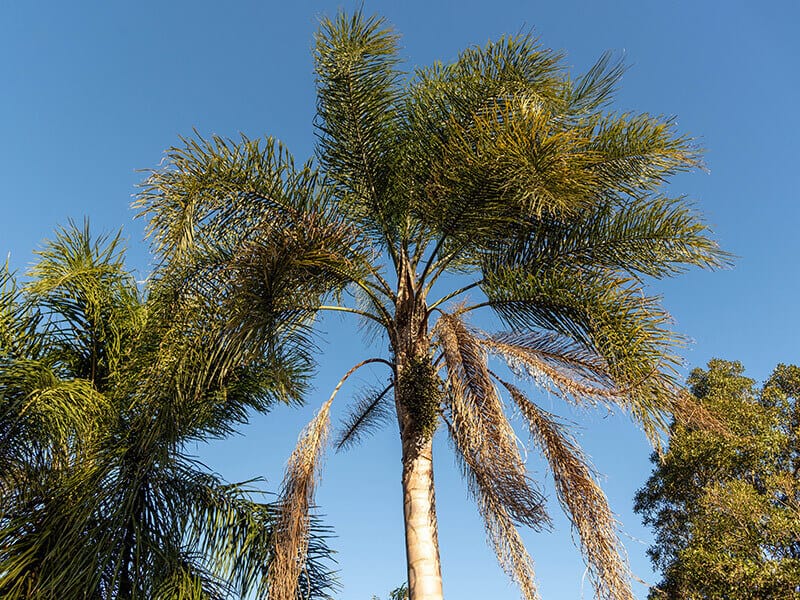
Syagrus romanzoffiana is a beautiful, tall palm with an average height between 50 and 70 feet.
You can easily grow this so-called Queen palm in well-drained soil but pick a bright spot. The plant needs regular watering cleaning. When you notice dead leaves, remove them to keep the plant good-looking!
17. Piccabeen Palm
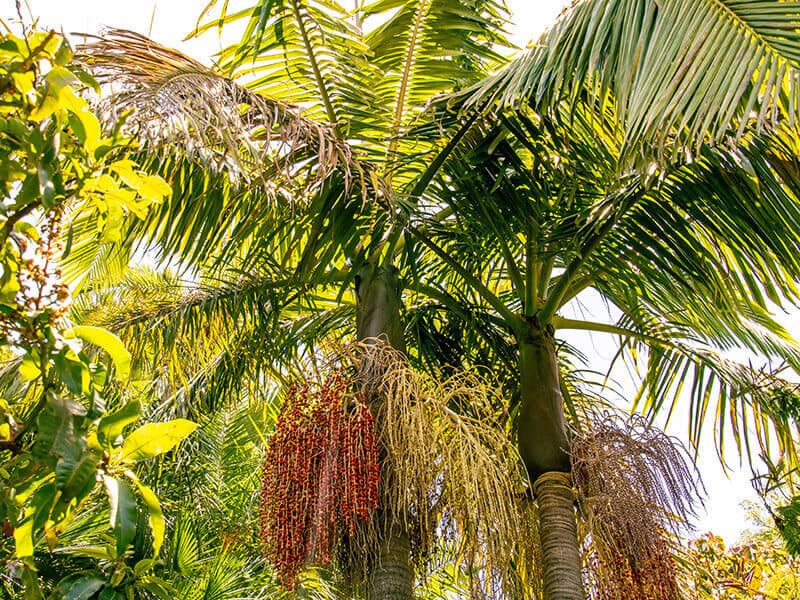
Archontophoenix cunninghamiana or Piccabeen palm is one of the palms suitable for colder climates. However, the palm cannot survive harsh frosts.
Piccabeen palm is a fast grower. Pick a partial shade or bright spot and ensure plenty of water to help the plant grow to its full potential.
18. Latania Palm
Latania lontaroides, shortly Latania palm is a beautiful palm to use for your landscape. Plant it in fertile and well-drained soil.
Keep an eye for the disease – yellowing because it can easily kill the plant. There are several species of this interesting palm, and all have slightly different foliage colors! Blue Latania palm is the most popular variety.
19. Foxtail Palm
Wodyetia bifurcata or Foxtail palm is a magnificent palm with a self-cleaning habit. Therefore, you don’t have to remove the dead leaves by hand, the palm will dispose of the old leaves!
You can find single or multi-trunk Foxtail palms, and both varieties look stunning in every landscape.
The palm needs a lot of fertilizer in spring, summer, and autumn, and can grow up to 30 feet.
20. Montgomery Palm
Veitchia arecina or Montgomery palm is a tall elegant palm that compliments every tropical landscape.
The plant thrives in a sunny spot and well-drained soil. If you need to transform your landscape fast, pick Montgomery palm because it has an astonishing fast-growing rate! Also, it can tolerate cold temperatures and mild frosts.
21. Buccaneer Palm
Pseudophoenix sargentii is a scientific name for the lovely Buccaneer palm. It is an ideal palm to plant near the patio because it tolerates light shade.
Buccaneer palm is salt-tolerant and common in coastal areas. It needs around ten years to grow to the full size!
22. Coconut Palm
Cocos nucifera or shortly Coconut palm is one of the most popular palms ever. You can grow it from fresh coconut with a husk!
The palm needs soil with excellent drainage and a lot of water. Because coconut palm is a heavy feeder, use fertilizer often. Next, keep in mind that coconut palm needs winter protection to survive.
Practical guide to treating pests on your Coconut palm.
23. Pygmy Date Palm
Phoenix robelinii or Pygmy date palm is a low-maintenance palm. However, once you first plant it, water it regularly to prevent the soil from drying completely. You can even water the plant every day during hot summer days!
Pygmy date palms need a consistent amount of fertilizer. Pick a slow-release fertilizer, high in nitrogen during the first year after planting.
24. European Fan Palm
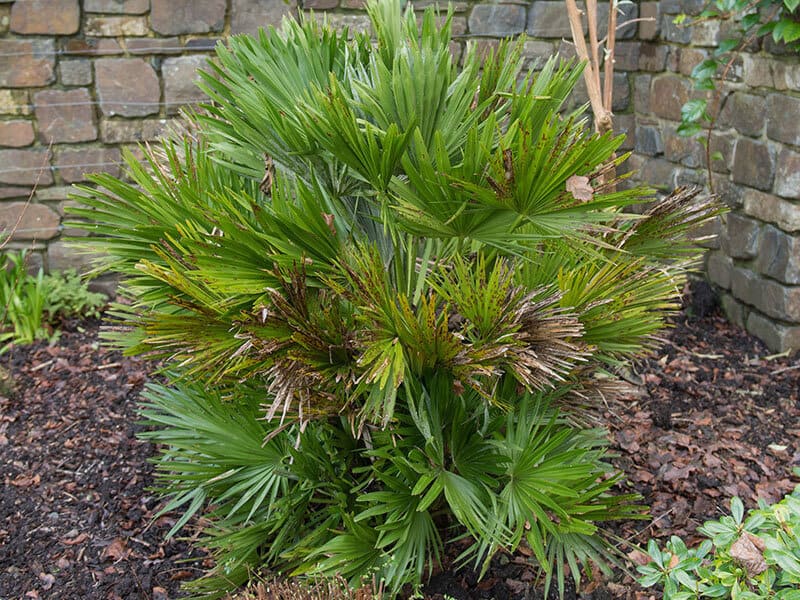
European Fan palm or Chamaerops humilis is easy to propagate by seeds. You can start the palm in the spring, once the danger of frost has passed. The germination usually takes several weeks and during that time, the seeds need to be moist.
The palm is tolerant to soils with different pH. The palm doesn’t grow too tall, and you can grow it in the container.
25. Ruffled Fan Palm
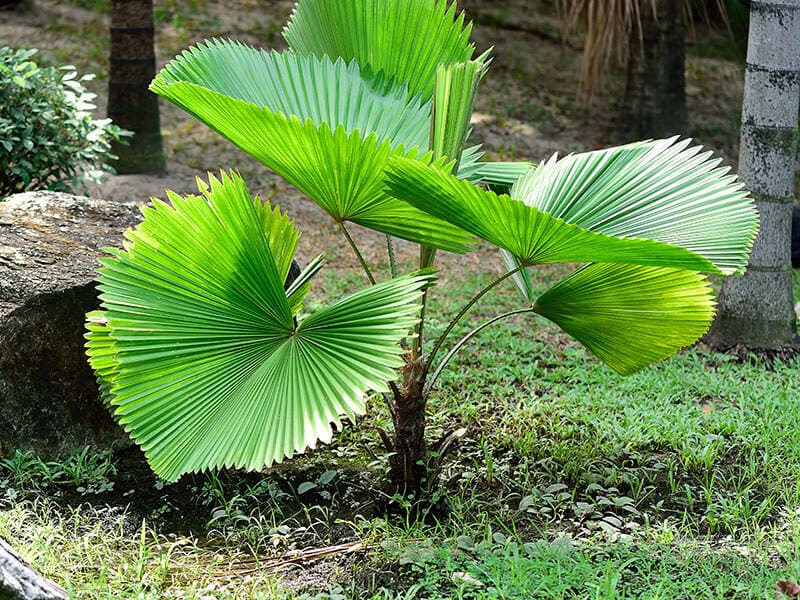
Licuala grandis or Ruffled Fan palm is one of the easiest palms to grow. Also, it is a rare plant that grows well in the shade!
Mature plants are tolerable of sun but will become prettier in the shade.
Ruffled Fan palm is a slow grower and only grows a few inches per year.
26. Sentry Palm
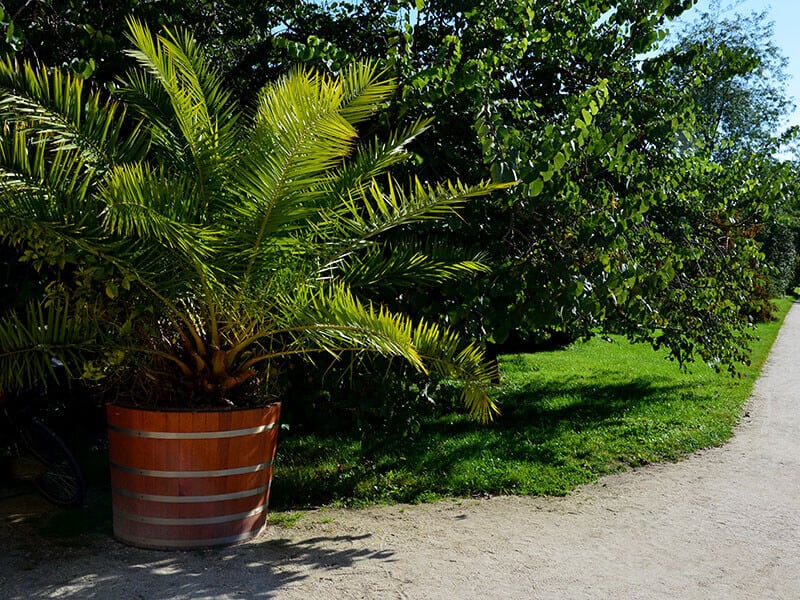
Howea belmoreana or Sentry palm survives indoors in colder climates and looks wonderful outdoors in tropical regions.
The plant needs partial shade and well-drained soil. You should water the plant when the soil feels dry! Keep in mind that palms in containers need more water than ones in the soil.
27. Christmas Palm
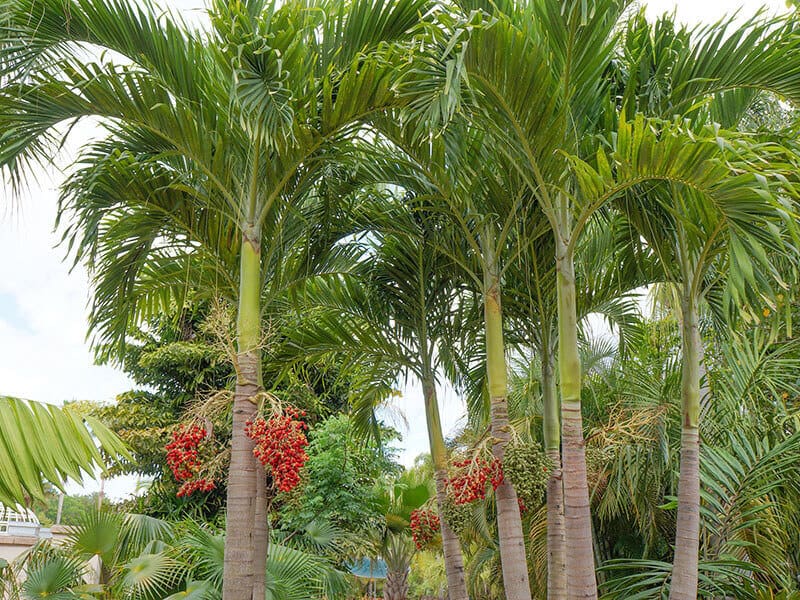
Adonidia merrillii or Christmas palm, grows best when it receives at least six or eight hours of sunlight per day. Young palms need a lot of water, but mature Christmass palms are somewhat drought tolerant.
Sandy soil is ideal for growing Christmas palm, and the plant is also salt-tolerant.
28. Yucca Palm
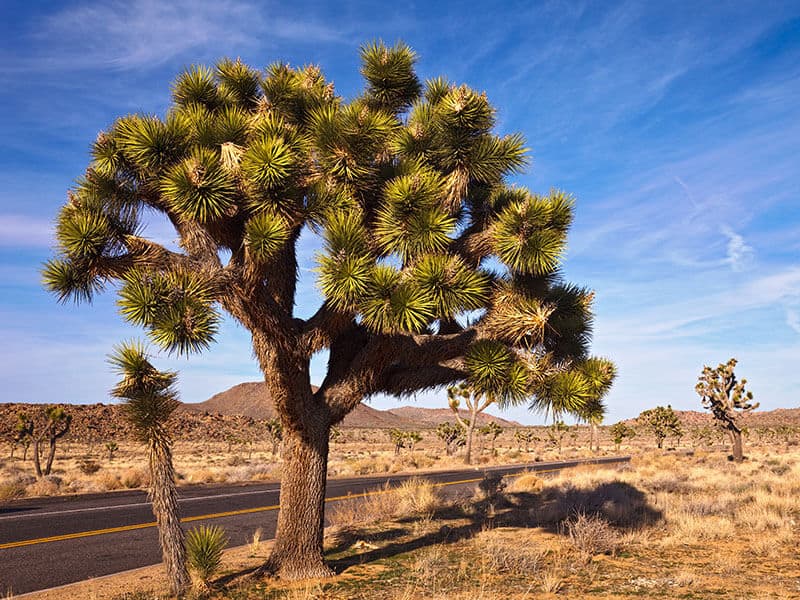
Yucca brevifolia, shortly Yucca palm, is an attractive palm and grows best in rocky soil. Excellent drainage is a must!
You can start your Yucca palm in the container and transplant it after several years. The ideal location for Yucca palm is a slight shade or partial sun. Yucca palm is known under the name Joshua tree.
Tips to grow Yucca palm from cuttings. You can see this video to know more:
29. Bamboo Palm
Chamaedorea seifrizii is the botanical name of the Bamboo palm. You can grow the palm in full shade, but the little sun will help the plant develop faster and become prettier. The plant needs consistent water and excellent drainage.
Water the plant once a week during colder weather and increase the watering frequency during hot days.
It is a multi-trunk plant that can spread between one and ten feet.
30. Sago Palm
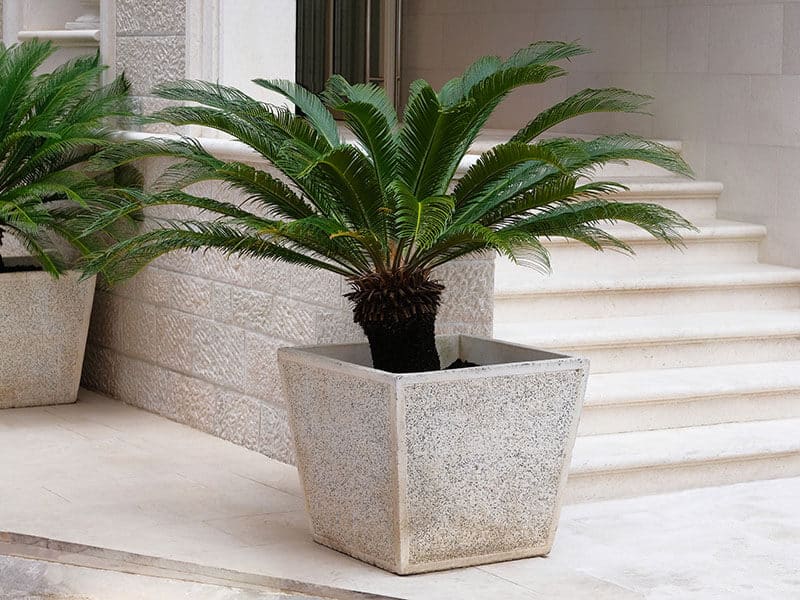
Cycas revoluta or Sago palm needs free-draining soil and a lot of sunlight to thrive. You can amend the soil with compost to achieve better results. The plant has a distinctive tropical vibe and survives outdoors only in warm climates. When the temperatures drop, the damage to the foliage appears.
It needs a moderate amount of water to grow. However, over-watering leads to root rot.
31. Majesty Palm
Ravenea rivularis proudly carries the common name – Majesty palm because of its majestic appearance. This single trunk palm has a fantastic crown.
It can grow in sandy soil and is tolerable to various lighting conditions. You can grow it in dappled shade or full sun location.
The palm is commonly grown in a container, indoors or outdoors, as a single specimen.
32. Carpentaria Palm
Carpentaria acuminata, shortly Carpentaria palm, needs rich and moist soil. It also needs to be well-drained and fertile so the palm can grow.
Carpentaria palm enjoys full sun exposure, and isn’t tolerant to salt and drought, like some other palms on the list.
You can propagate it by seeds.
33. Cardboard Palm
Zamia furfuracea or Cardboard palm is a popular houseplant but can be grown outdoors during warm parts of the year, or year-round in hot climates. The palm is native to Mexico.
Cardboard palm is a slow grower and a low-maintenance plant. It needs bright light to grow, and a lot of water during the growing season. In winter, reduce the watering frequency!
You can see this video to know more:
34. Caranday Palm
Caranday palm or Copernicia alba gets around 40 feet tall!
The plant doesn’t need complex care. Plant it in full sun location and well-drained soil. It is also tolerant of many pests and diseases and doesn’t need pruning!
You can easily propagate the Caranday palm by seeds! The germination process might take two to four months, but it is worth waiting!
35. Bottle Palm
Attractive Bottle palm needs years to achieve full size. In ideal locations, the Hyophorbe lagenicaulis grows up to 12 feet.
The palm needs frost protection and regular trimming of dead leaves. You can amend the soil with high-potassium fertilizer in the spring. It will boost growth.
Why is Bottle palm an all-time collector’s favorite palm tree?
36. Cabbage Palm
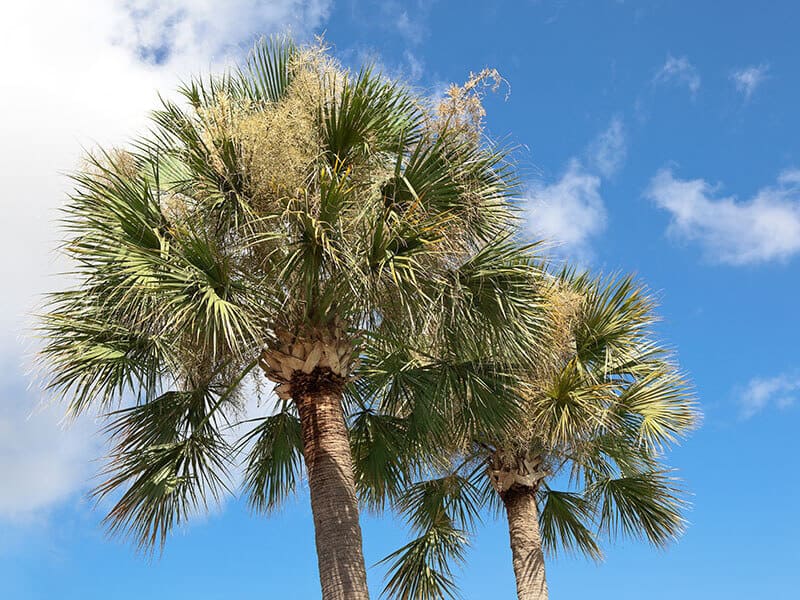
Sabal palmetto or Cabbage palm is a very tall palm, with an average height between 40 and 50 feet. The palm thrives in moist, well-drained soil and bright spots. On average, the palm grows around six inches per year! Interestingly, Sabal palmetto is a long-living palm with an average lifespan of three centuries!
37. Blue Hesper Palm
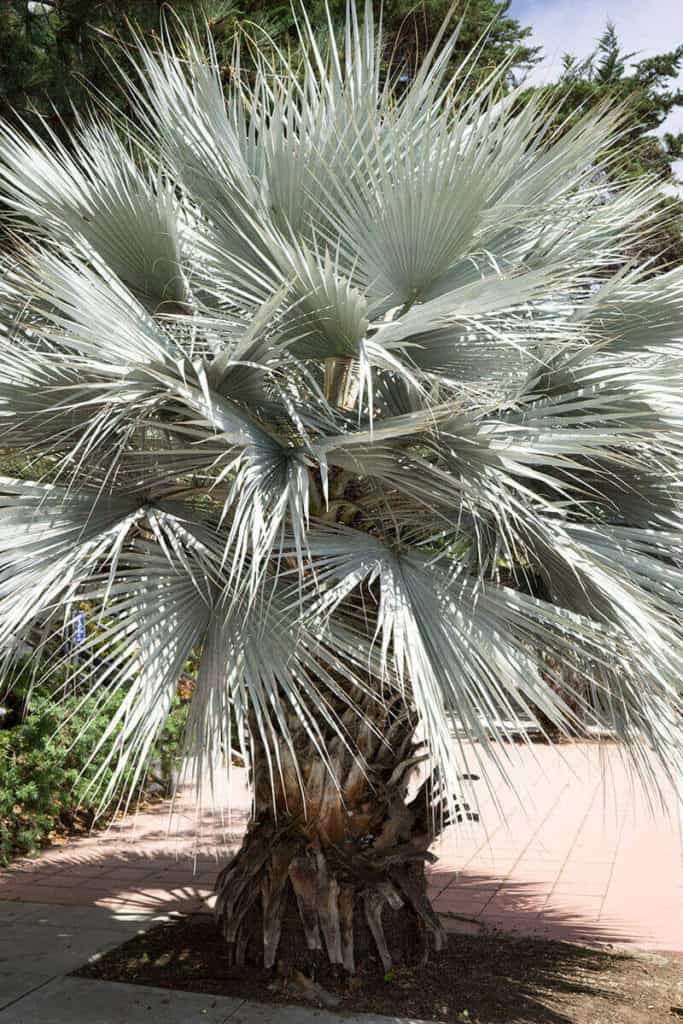
Brahea armata or Blue Hesper palm needs wind protection. Ideal growing conditions include excellent drainage, alkaline soil and six hours of sunlight per day.
Mature palms are hardy and can tolerate cold weather. However, young palms need winter protection, and you can start them in containers first, and transplant them in soil when they are ready.
38. Banana Palm
Musa or Banana palm needs fertile soil to grow. When you first plant it, your Musa needs a lot of water. You can mulch around the roots to help the plant retain moisture better. It will also protect the roots from cold temperatures.
You can grow Musa in full sun or partial shade.
39. Bailey’s Copernicia Palm
Copernicia baileyana or Bailey’s Copernicia palm has moderate watering needs. It is tolerant of poor-quality soils and drought.
Grow Bailey’s Copernicia Palm in a bright spot for an ideal appearance
The average height the palm can reach is between 30 and 40 feet.
40. Acai Palm
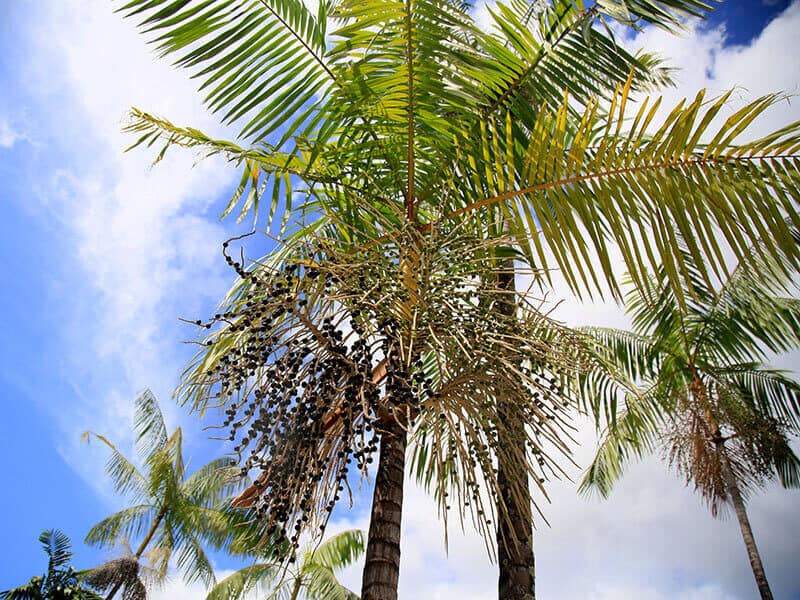
Acai palm or Euterpe oleracea prefers some shade and acidic soil. Ideal temperatures for Acai palm are above 21 degrees Fahrenheit. You can also grow the palm in a container with drainage holes.
Container plants need more water than the ones planted in the backyard.
41. Canary Island Date Palm
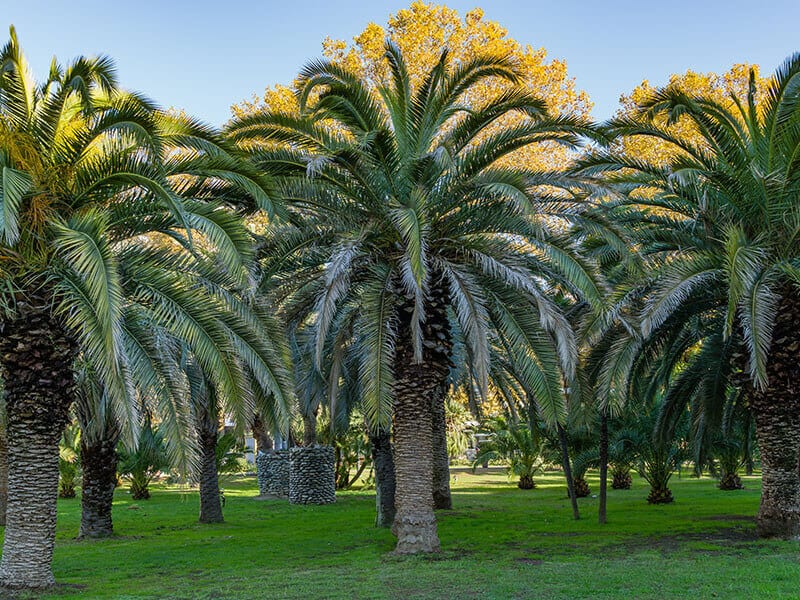
Phoenix canariensis is the botanical name of the palm often referred to as Canary Island Date palm. The tree tolerates soils of different quality and pH, but it needs excellent drainage. The palm prefers full sun exposure and a lot of moisture.
Mature Canary Island Date palms are very tall, about 60 feet.
42. Princess Palm
Dictyosperma album or Princess’s palm is a typical coastal tree. It needs sun exposure and consistent watering to grow. In ideal conditions, Princess palm has a relatively fast growth rate.
Some people also call it Hurricane palm.
43. Purple King Palm
Archontophoenix purpurea is the botanical name of Purple King palm. If you live in a colder climate, you can grow this palm as long as the temperatures don’t drop below 25 degrees Fahrenheit. However, only mature plants are cold-tolerant and young ones need protection.
The palm is self-cleaning and only needs little maintenance. You have to water it thoroughly, especially during warm parts of the year. The plant grows best in part shade, but it can tolerate full sun exposure with plenty of water.
44. Pindo Palm
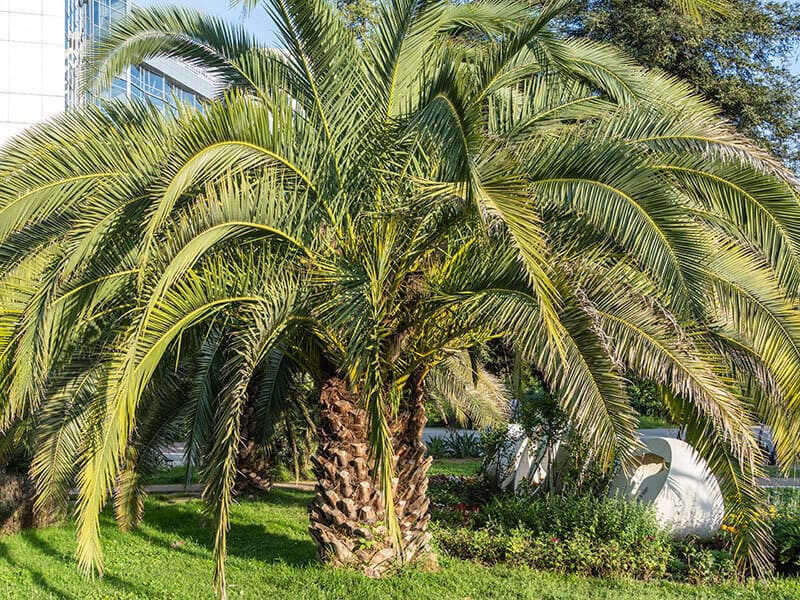
Butia capitata or Pindo palm needs a sheltered position and at least half an inch of water every week. In winter, reduce the watering.
You can grow Pindo palm from seeds. But, I recommend getting an established tree from a nursery, rather than growing it from seeds because of the slow growth rate. Interestingly, seeds can also be roasted and used for coffee making.
Pindo palm is a slow grower. It will need several years to reach its full height, around 20 feet.
45. Orange Crownshaft Palm
Orange Crownshaft palm is an exotic tree with a wonderful visual effect. The palm got the name because of the beautiful orange shaft. The scientific name of the plant is Areca Vestiaria, and the palm can be difficult to find in nurseries.
You can also grow it indoors, from seeds. The germination is slow and may take from two to three months. Overall, the Orange Crownshaft palm grows slowly, but it is worth waiting for! The beautiful orange crownshaft will instantly brighten any landscape!
46. Old Man Palm
Coccothrinax crinita or Old Man palm is often found around the seashore, because of its exceptional salt and drought tolerance. It thrives outdoors in zones from 10B to 11, where the temperatures are above 40 degrees Fahrenheit.
The ideal conditions include partial shade or full sun!
You can also grow the palm in pots and display it around the entrance.
47. Mule Palm
Butiagrus nabonnandii or Mule palm is very similar to the coconut palm. It is often recommended for colder zones because Mule palm grows easily where Coconut palm cannot!
Excellent drainage is requirement number one for Mule palm. Additional requirements include full sun or partial shade spots and consistent watering.
48. Chusan Palm
Trachycarpus fortunei Wagnerianus or Chusan palm is sometimes called Waggie palm. If you want to maximize the visual effect of Chusan palm, plant several palms in your backyard for the greatest tropical effect.
The palm isn’t self-cleaning and requires your assistance to stay good-looking. It is a drought-tolerant and space-saving plant, a great choice for small gardens.
49. Mexican Fan Palm
Washingtonia robusta or Mexican Fan palm is a low-maintenance plant. Mature palms feature excellent salt, wind, and drought tolerance. It is a tall plant, often used around the coast, because of its height.
Grow it in well-drained soil and bright spot.
50. Metallica Palm
Metallica palm or Chamaedorea Metallica isn’t a typical palm! It is a small plant, often used in commercial spaces as decoration.
The palm is a slow grower and resilient to many conditions. Naturally, Metallica palm grows in shady areas in the forests of Mexico, so keep the plant away from direct sunlight.
Water thoroughly to ensure the prettiest foliage.
51. Mazari Palm
Most Mazari palms grow between ten and 20 feet in height, and between five and ten feet in width. The palm has a moderate growth rate and low-maintenance nature.
You can grow in sandy soil, in the garden, or pots. The palms grown in the ground get significantly taller and bushier than the ones in containers.
The scientific name of the palm is Nannorrhops ritchiana.
52. Macaw Palm
You can grow Macaw palm from seeds, but wait when the temperatures go above 75 degrees Fahrenheit to scarify the seeds. With these seeds, germination is slow, so don’t expect the seedlings to appear in the first four months.
The botanical name is Aiphanes minima, and the palm tree care is simple. The palm is also cold-tolerant and it doesn’t need winter protection.
53. Key Thatch Palm
Leucothrinax morrisii or Key Thatch palm requires mulching around the roots and a lot of sunlight. Older plants are drought and salt-tolerant and common parts of the coastal landscape.
You can grow the Key Thatch palm from seeds.
54. Joey Palm
Johannesteijsmannia altifrons or the famous Joey palm is easily recognizable by its large, undivided foliage! It is native to Southeast Asia and looks great outdoors and indoors, as a houseplant.
Joey palm can tolerate cold weather, but cannot survive temperatures below 25 degrees Fahrenheit. It can benefit from standard palm fertilizer!
55. Jade Empress Palm
Rhapis multifida or Jade Empress palm comes from China. This compact, evergreen palm develops lovely dark green, narrow and long leaves. The palm is evergreen but looks most beautiful in the summer when it develops small yellow flowers!
It is a low-maintenance palm, which doesn’t need pruning.
56. Guadalupe Palm
Brahea edulis is the botanical name of the beautiful Guadalupe palm. It grows up to 40 feet in height when you fulfill the growing requirements. Those include well-draining soil, a lot of moisture, and plenty of sunlight hours!
Guadalupe palm doesn’t require pruning and is wind, salt, and drought tolerant.
57. Florida Thatch Palm
Florida Thatch palm or Thrinax radiata prefers sandy soil, but the palm is adaptable to various conditions. Thrinax radiata doesn’t need a lot of water.
The palm also develops interesting white and green fruits, but these aren’t edible.
58. Flame Thrower Palm
Flame Thrower palm is an easy-going, rare, and exotic palm. The scientific name of this cold-hardy palm is Chambeyronia macrocarpa, and it has numerous common names. Some people call it the Blushing palm because of the red undersides of the leaves.
The palm needs a partial shade location, and a lot of water, especially during the summer.
59. Cuban Belly Palm
Acrocomia crispa or Cuban Belly palm is one of the most expensive outdoor palms. This beautiful palm is easy to grow. It is tolerant of dry spells and alkaline soil. You might struggle to find the plant in the local nursery, but tracking it down is worth the effort! It is an exotic, cold-hardy palm with a slow-growth rate.
60. Coyure Palm
Coyure Palm or Aiphanes horrida grows up to 30 feet in its native habitat – moist and tropical parts of South America.
It is best known for its edible fruit with sweet pulp and high levels of vitamin A.
You can grow it from seeds and germination takes around three months.
You can see this video to know more:
61. Cuban Petticoat Palm
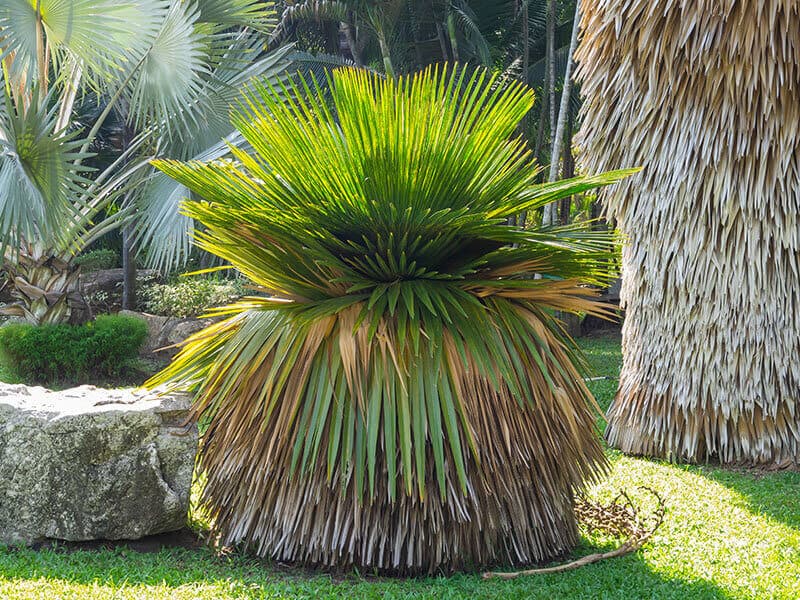
Cuban Petticoat palm features fan-shaped foliage without petioles! It makes this palm unique! The palm is known under the scientific name Copernicia macroglossa.
It can tolerate drought, coldness and can be a perfect houseplant!
62. Saw Palmetto Palm
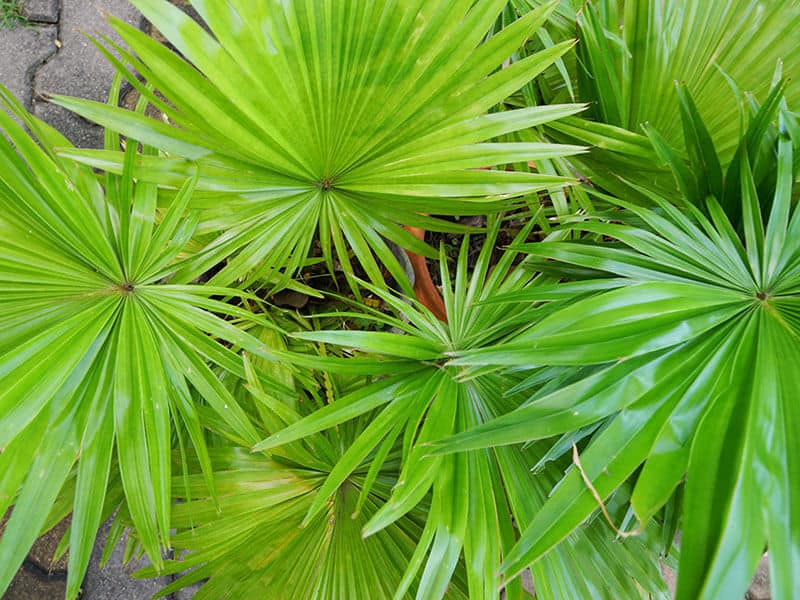
If you want an adaptable, low-maintenance palm plant to improve your garden landscape, check Saw Palmetto palm, the botanical name Serenoa repens. Even though the palm prefers full sun, it can adapt to partial or full shade.
Once you first plant it, amend the soil with plenty of water. Once your plant gets established, it becomes low-maintenance.
Occasionally, remove dead leaves to keep the plant tidy.
63. Spindle Palm
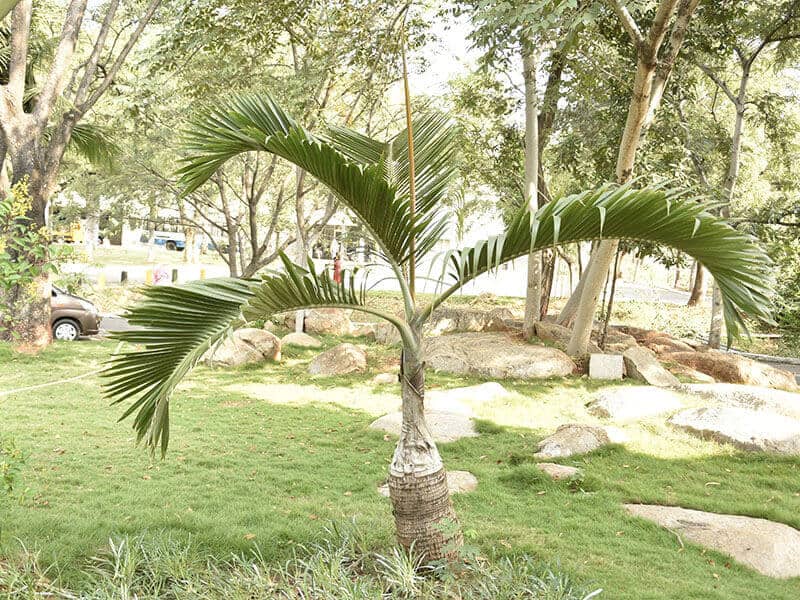
Spindle palm or Hyophorbe verschaffeltii requires a lot of sunlight and wind protection. The ideal location for the plant is southern or western house edge! Plant it at least four feet away from the house to give the crown space it needs to develop!
64. Teddy Bear Palm
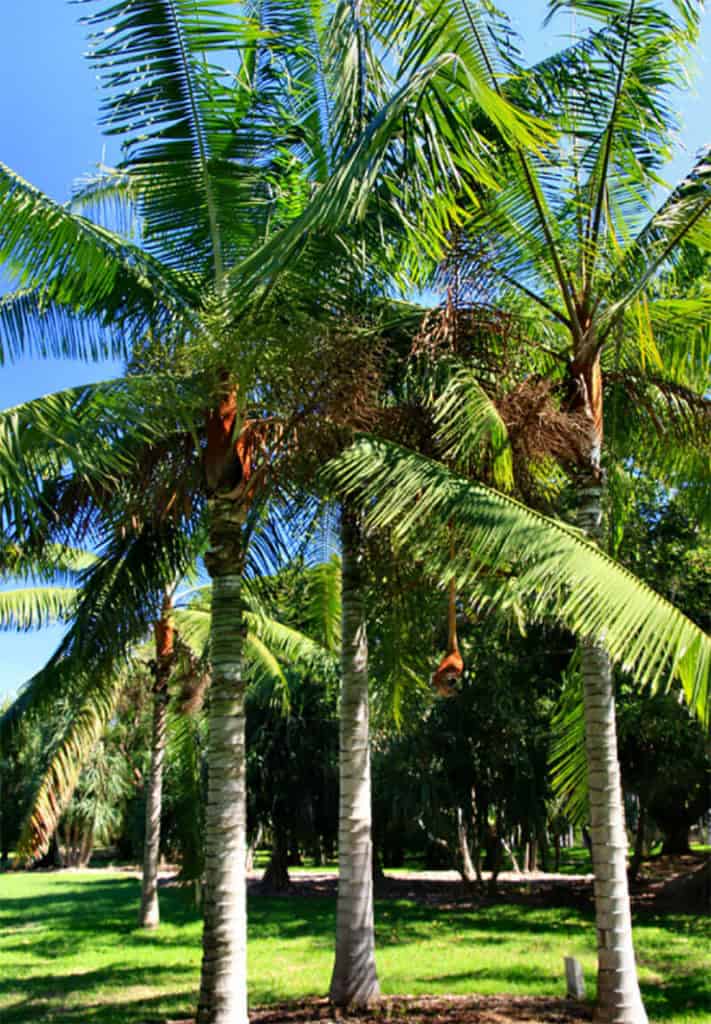
Neodypsis lastelliana or Dypsis leptocheilos is known under the cute name – Teddy Bear plant. It needs well-drained soil. You can use the organic mix to boost the soil nutrients. In addition, enrich the soil three times per year using a slow-release fertilizer.
65. Travelers Palm
Travelers Palm is a disease-resistant palm, which prefers moist and fertile soil. The trick to growing the most beautiful Travelers palm, scientific name Ravenala madagascariensis, is to ensure the plant receives shade at the base once you plant it in the ground.
It won’t take long until your Travelers palm gets established. Then, it becomes low-maintenance.
66. Triangle Palm
Dypsis decaryi is often called Triangle palm, by triangular-shaped frond. The palm features a slow growth rate and doesn’t need regular pruning.
You can use palm fertilizer to boost the growth of the palm during the growing season – in spring, summer and fall. Don’t forget to water the palm thoroughly!
67. Kaivatu Palm
Veitchia vitiensis or Kaivatu palm is a somewhat rare palm plant with an exceptional growth rate! The plant is native to Fiji and easy to grow in tropical regions. However, getting the Kaivatu palm seeds can be tricky.
The palm is adaptable to most conditions but needs warmth to grow.
68. Needle Palm
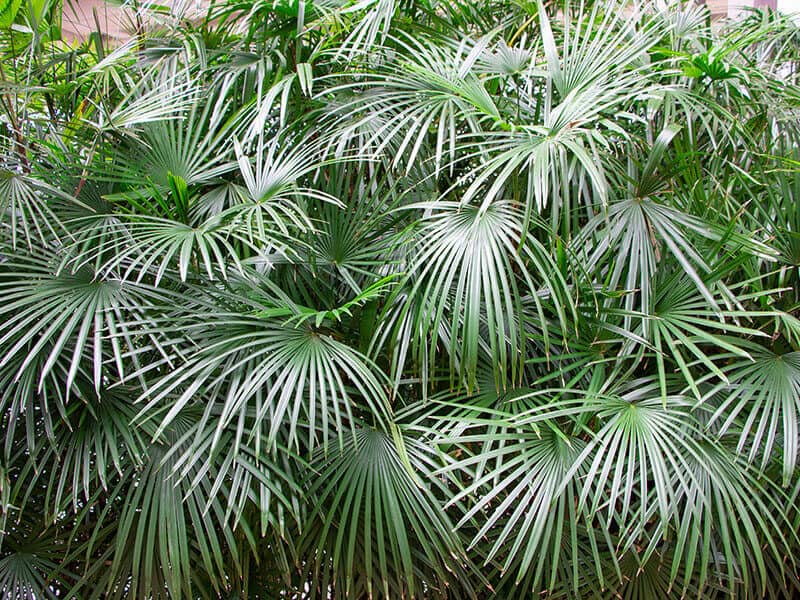
Rhapidophyllum hystrix is also called Needle palm because of the long, narrow, and pointy foliage, which looks like dark-green needles.
Needle palm prefers organically rich and airy soil. It needs winter protection and plenty of sunlight to thrive. The palm can benefit from mulching around the base in the fall to protect the roots in winter!
It is short, and you can plant it under the trees. Needle palms also look good around the pools.
69. Kosi Palm
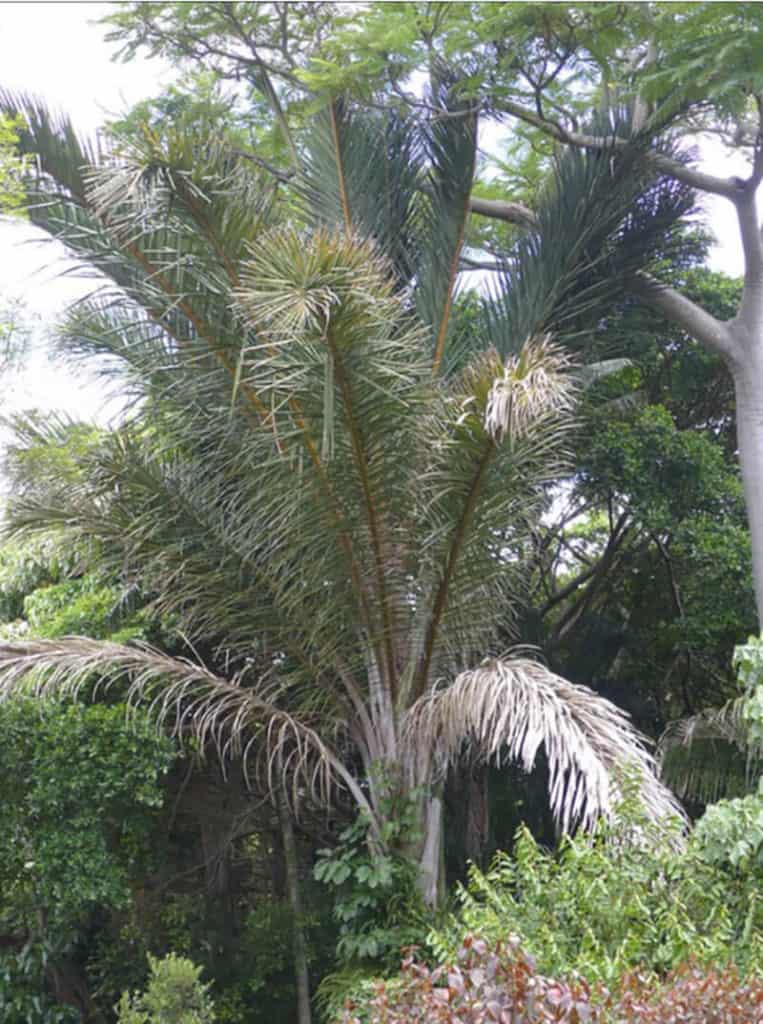
Raphia australis or Kosi palm is rarely cultivated for individual planting. It is more common in commercial and large gardens. However, Kosi palm is one of the most beautiful palms ever, with huge leaves and upright growing habit!
It gives a dramatic effect to every garden or park. The palm is frost-sensitive.
70. Wettinia Palm
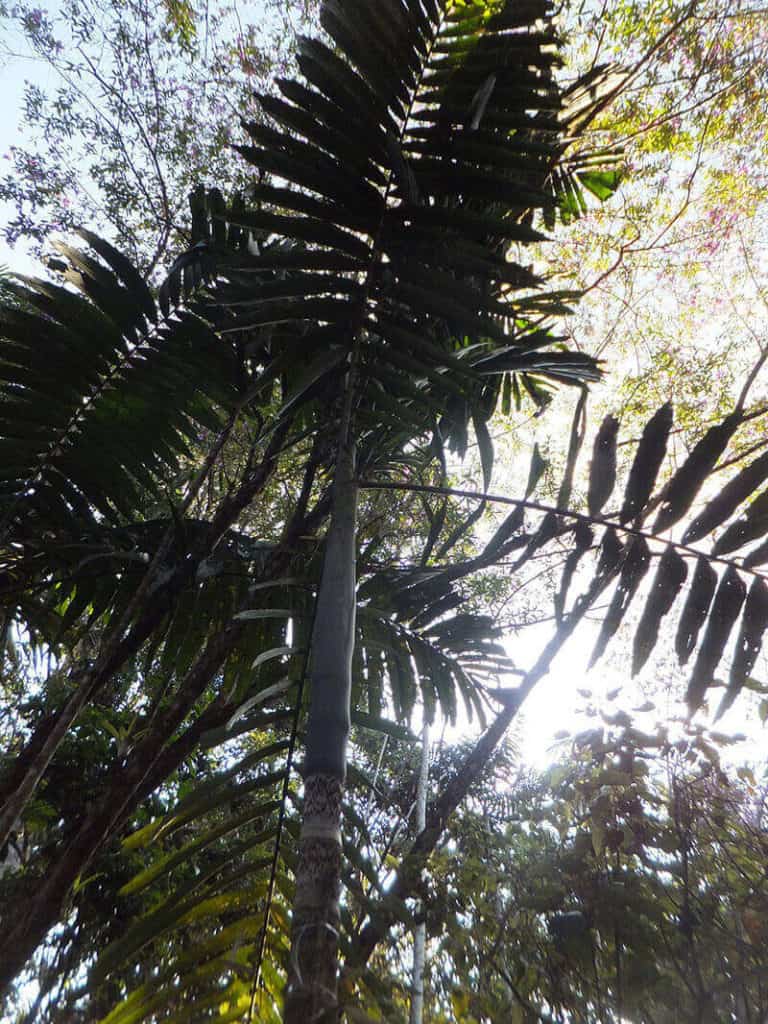
The single-stemmed and evergreen palm called Wettinia maynensis is often grown for its sturdy trunk. The trunk is used for construction because of its exceptional features.
Interestingly, the leaves of Wettinia palm are edible. They are called palm hearts and are often on the menu of vegetarians!
71. Zombie Palm
Zombia antillarum or Zombie palm slowly grows if you don’t use fertilizer. Mature palms can go without fertilizer.
The palm prefers fertile soil and lots of water but needs excellent drainage to remain healthy.
You can grow it in a bright spot or partial shade.
72. Coontie Palm
If you are patient, you can grow Coontie palm or Zamia pumilia from seeds. The germination is slow and sometimes not successful. Instead, you can buy an established plant from a nursery and transplant it in well-drained soil.
Use compost or ammoniacal nitrogen to boost growth.
73. Arenga Palm
Arenga engleri, shortly Arenga palm, is an adaptable, easy-to-grow palm with clustering growing habit. It is a moderately tall palm, with an average height from eight to ten feet. The palm is sometimes called Dwarf sugar palm.
Water it thoroughly, but only if the soil has suitable drainage. Use a palm fertilizer three times per year for best results.
74. Arikury Palm
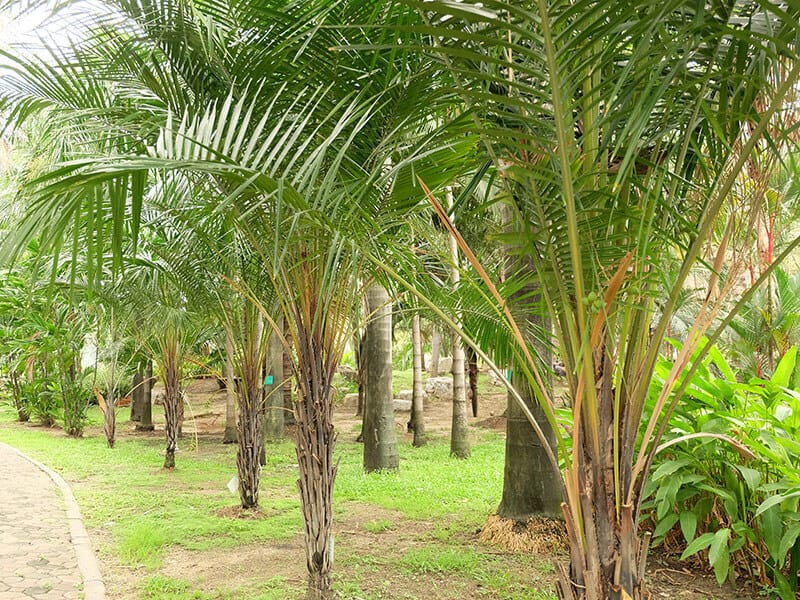
Syagrus schizophylla or Arikury palm is a slow-growing, low-maintenance plant. It needs regular watering and excellent drainage to develop. If you want to achieve the best visual effect, plant several Arikury palms in a row, at five feet distance.
Use standard palm fertilizer in spring, summer, and autumn, and reduce watering in winter.
75. Windmill Palm
When you plant Trachycarpus fortunei or Windmill palm in the bright spot, it showcases its true beauty! The palm features ornamental bright green and yellow foliage.
Windmill palm can grow between ten and 40 feet in height, and get between six and ten feet wide.
76. True Date Palm
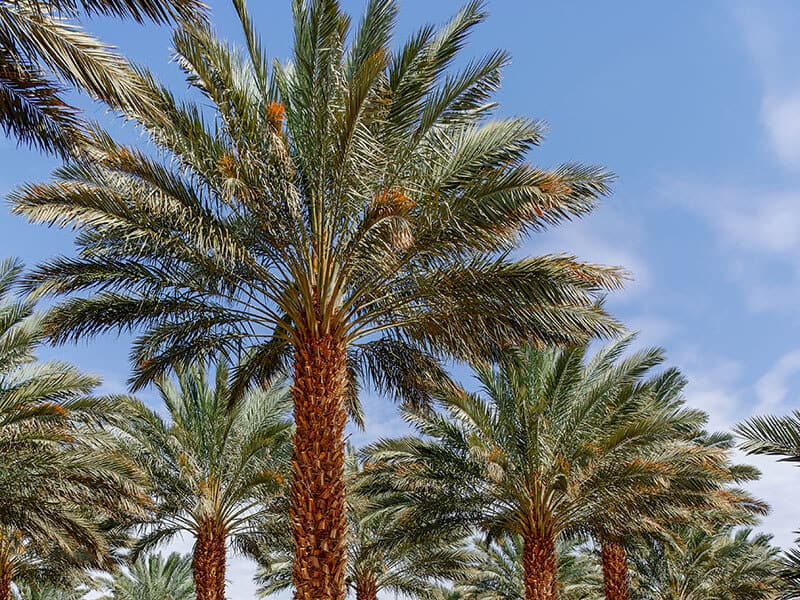
Phoenix dactylifera or True Date palm is native to the Arabian peninsula and parts of Africa. You can start it from seeds and those will need around two months to germinate.
The palm isn’t prone to pests and diseases, and usually grows up to 50 feet or taller. It features a self-cleaning habit, so you don’t have to remove old leaves.
77. Winin Palm
Veitchia winin is a rare and beautiful palm plant. You can grow it from seeds in warm areas, such as California and Florida. The average height of the Winin palm is between 30 and 40 feet.
Water the plant often and don’t let the soil dry completely between two waterings.
78. Trithrinax Palm
Trithrinax schizophylla, shortly Trithrinax has a sturdy trunk, often used as construction material. The palm enjoys a lot of moisture and high humidity. It grows best in sandy soil and gets around 30 feet tall.
79. Dragonhead Palm
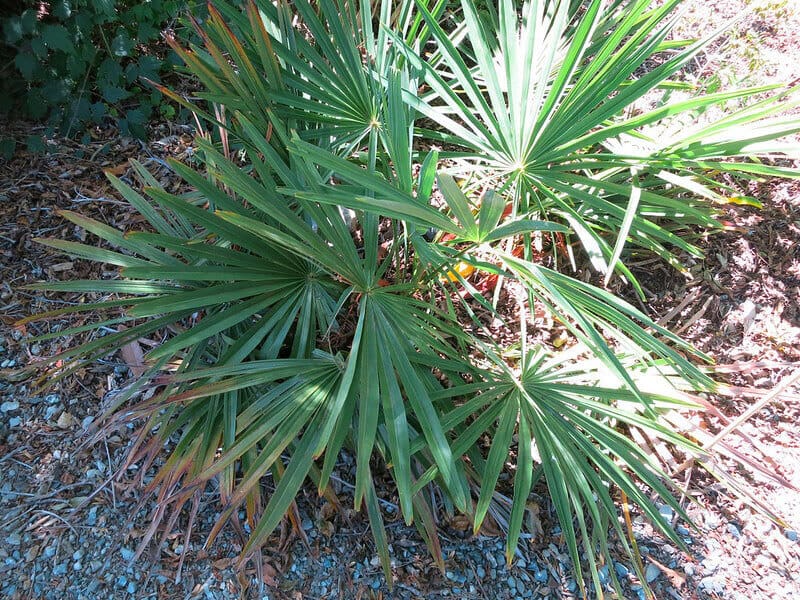
Until recently, Trachycarpus nanus or Dragonhead palm was one of the rarest palms ever. Nowadays, the seeds are available, but only in well-supplied nurseries. The lighting requirements for these attractive palms are dappled shade and wind protection.
The palm is a heavy feeder, and you can use manure or liquid fertilizer during spring, summer, and autumn.
Because the palm isn’t self-cleaning, you’ll have to remove old leaves regularly.
80. Amargo Palm
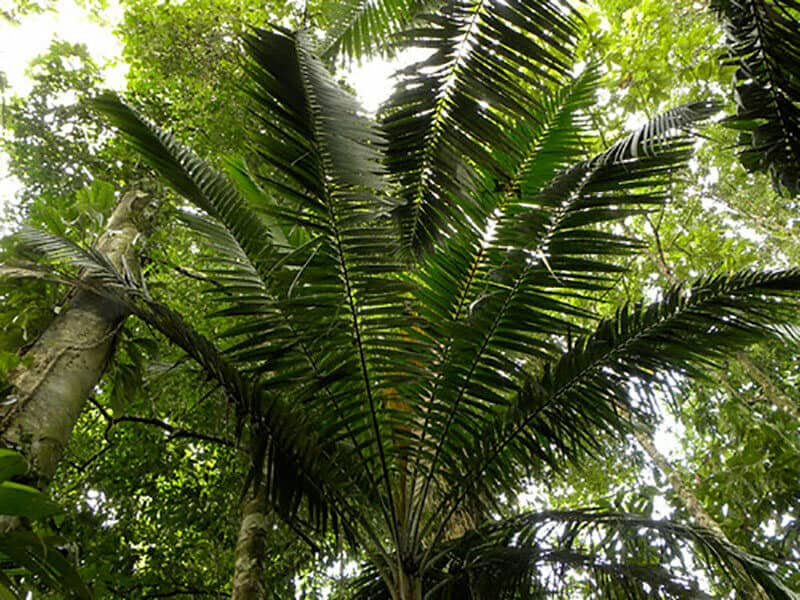
Welfia regia or Amargo palm is a stunning palm with unique foliage. When they first appear, the new leaves are dark red! The palm is native to Honduras and has high ornamental value.
It grows best in light shade and has moderate watering requirements.
81. California Fan Palm
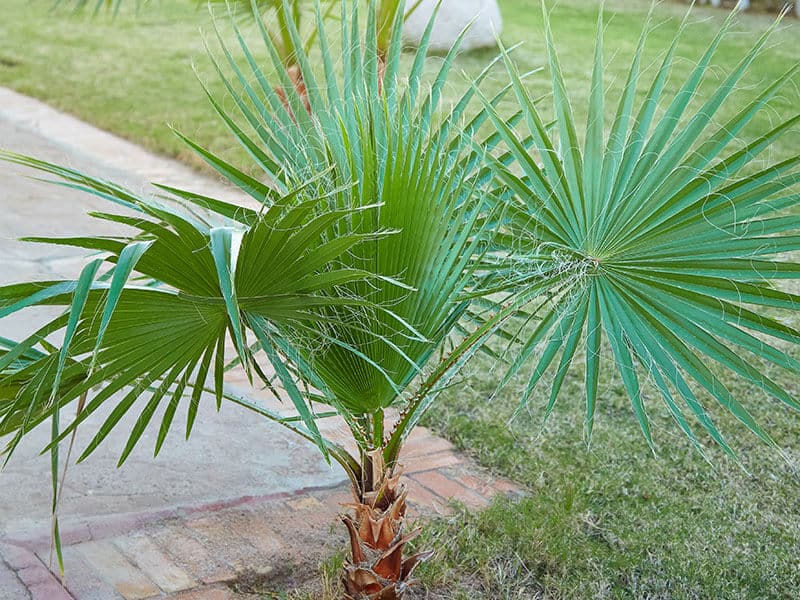
Washingtonia Filifera or California fan palm is a cold-resistant palm, which can survive temperatures below 20 degrees Fahrenheit. But, the plant needs full sun exposure to remain healthy year-round. You can also use compost in the fall to prepare the plant for the upcoming winter.
Palms Are Always A Great Idea
You’ve made it to the end of the list, but are you closer to deciding which palm plants you grow outdoors? With a few palms in your garden, you can easily create your own tropical paradise!
I love Sentry palm and the Majesty palm, but I wouldn’t mind getting my hands on the seeds of some rare palm plants!
If you enjoyed the list, please give the article a thumbs up! Come back for more attractive plant lists and gardening tips!
